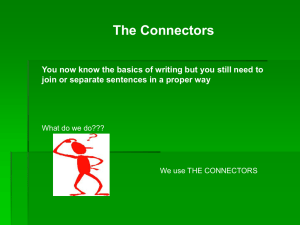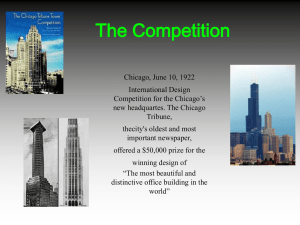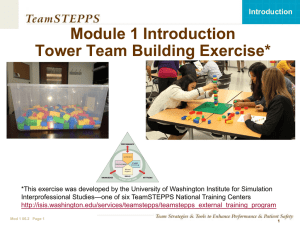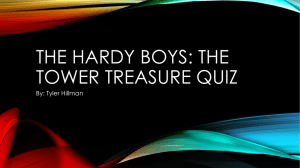Coaxial Cable Inspections
advertisement
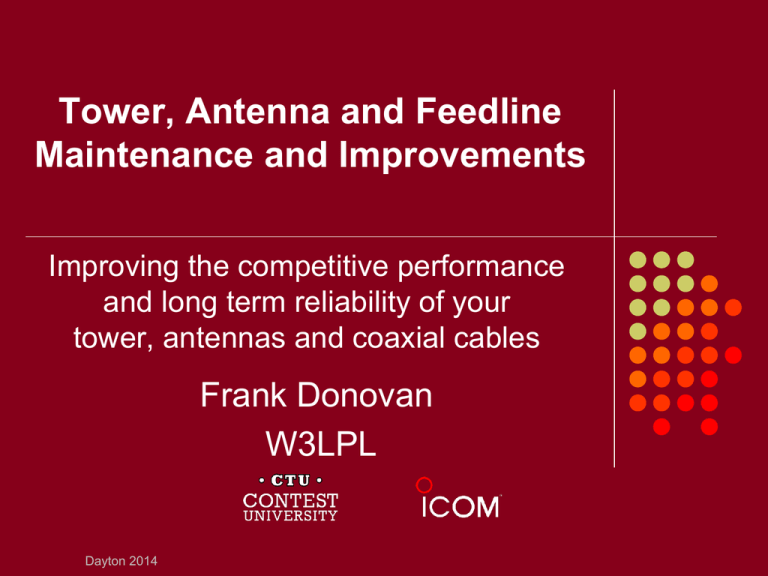
Tower, Antenna and Feedline Maintenance and Improvements Improving the competitive performance and long term reliability of your tower, antennas and coaxial cables Frank Donovan W3LPL Dayton 2014 This is a Great Time to Improve and Maintain Your Antennas! 2015 prediction Sunspot Number Feb 2014 peak http://solarscience.msfc.nasa.gov/images/ssn_predict_l.gif 2 Improving the Competitive Performance of a Single Tower Station 50-60 foot tower and a small rotator (e.g., HyGain Ham-IV) 70-80 foot tower and a medium rotator (e.g. HyGain T2X) small tribander, Hex-beam or quad 40 and 80 meter dipoles and a 160 meter inverted-L Cushcraft XM-240 two element 40 meter Yagi large tribander such as the SteppIR 4 element Yagi 80 meter dipole and a 160 meter inverted-L 100-140 foot tower and a large rotator (e.g., M2 Orion) Cushcraft XM-240 two element 40 meter Yagi monoband Yagis such as the HyGain LJ series on ring rotators 80 meter dipole and a 160 meter inverted-L Improving the Competitive Performance of 10 Meter Antennas Horizontal polarization is always your best choice if you can install your antenna only 25 feet high or higher otherwise use a four-square vertical array with extensive radials Moderate gain: a tribander, small Yagi, Hex-beam or quad a small Yagi 25-50 feet high will produce good results a small Yagi at 30-50 feet high for Sweepstakes and Field Day High gain: a full size tribander, small monoband Yagi or quad, at 50-70 feet high for excellent DX results Highest gain: two stacked monoband Yagis on a 60-70 foot tower (or 90-120 feet high for three stacked Yagis) stack switching ( a “stackmatch”) provides high payoff at low cost Stacked 6 Element 10 Meter Yagis 20 18 16 14 12 10 8 6 4 2 0 70 ft 12º Europe BOTH 8º decibels 0 -2 -4 3º -6 -8 -10 -12 -14 -16 -18 35 ft -20 elevation angle in degrees 36 Foot Booms 35 and 70 Feet High Asia/ VK/ZL 2º The Array Solutions Stack Match www.arraysolutions.com/Products/stackmatch.htm Improving the Competitive Performance of 15 Meter Antennas Horizontal polarization is always your best choice if you can install your antenna 35 feet high or higher otherwise use a four-square vertical array with extensive radials Moderate gain: a tribander, small Yagi, Hex-beam or quad a small Yagi at 35-50 feet high will produce good DX results a small Yagi at 35-50 feet high for Sweepstakes and Field Day High gain: a full size tribander, small monoband Yagi or quad at 70-90 feet high for excellent DX results Highest gain: two stacked monoband Yagis on a 80-100 foot tower (or 120-140 feet high for three stacked Yagis) stack switching ( a “stackmatch”) provides high payoff at low cost Stacked 6 Element 15 Meter Yagis 20 18 16 14 12 10 8 6 4 2 0 15º Europe 94 ft BOTH 10º decibels 0 -2 -4 4º -6 -8 -10 -12 -14 -16 -18 47 ft -20 elevation angle in degrees 48 Foot Booms 47 and 94 Feet High Asia/ VK/ZL 3º Improving the Competitive Performance of 20 Meter Antennas A horizontal Yagi or quad is always your best choice if you can install your antenna 50 feet high or higher otherwise use a four-square vertical array with extensive radials Moderate gain: a small tribander, Yagi, Hex-beam or quad a small Yagi at 50-70 feet high will produce good DX results a small Yagi at 40-50 feet high for Sweepstakes and Field Day High gain: full size triband Yagi, small monoband Yagi or a quad at 70-100 feet high for excellent DX results Highest gain: two stacked monoband Yagis on a 100-140 foot tower (or 170-200 feet high for three stacked Yagis) stack switching ( a “stackmatch”) provides high payoff at low cost Stacked 5 Element 20 Meter Yagis 20 18 16 14 12 10 8 6 4 2 0 18º Europe 100 ft BOTH 0 -2 -4 5º -6 -8 -10 -14 -16 -18 -12 decibels 12º Asia/ VK/ZL 50 ft -20 elevation angle in degrees 48 Foot Booms 50 and 100 Feet High 4º Improving the Competitive Performance of 40 Meter Antennas High horizontal dipole at least 70 feet high for DX contests Higher gain: 2 element Yagi at 70-100 feet high significant improvement over a simple horizontal dipole for DX a Cushcraft XM-240 at 70-100 feet high is very cost effective www.cushcraftamateur.com/Product.php?productid=XM-240 Highest gain: full size 3 element Yagi at 100-140 feet high otherwise use a four-square vertical array with extensive radials a dipole at 35-50 feet high for Sweepstakes and Field Day but don’t underestimate the high cost and complexity of the effort ! High performance receiving antennas Beverages and arrays of short verticals Stacked 3 Element 40 Meter Yagis 20 18 16 14 12 10 8 6 4 2 0 23º Europe 200 ft 15º BOTH 7º decibels Asia/ VK/ZL 0 -2 -4 5º -6 -8 -10 -12 -14 -16 -18 100 ft -20 elevation angle in degrees 48 Foot Booms 100 Feet and 200 Feet High Improving the Competitive Performance of 80 Meter Antennas High horizontal dipole, at least 70 feet high for DX contests 50-70 feet high for Sweepstakes and Field Day A single full size vertical or a vertically polarized delta loop well separated from all nearby tall towers A short inverted-L or T-vertical is a very good alternative at least 70 feet from nearby towers over 40 feet tall much more than 70 feet of spacing optimizes performance as little as 25 feet tall supported from a tower or trees Use at least 32-64 shallow buried radials at least 70 feet long, or at least two (but preferably four or more) elevated 65 foot radials but only if buried radials are impossible Improving the Competitive Performance of 160 Meter Antennas A single full size vertical or a vertically polarized delta loop well spaced from all nearby tall towers A short inverted-L or T-vertical is a very good alternative at least 140 feet from nearby towers over 80 feet tall spacing much more than 140 feet optimizes performance as little as 50 feet tall supported from a tower or trees Use at least 32-64 shallow buried radials At least 130 feet long or at least two (but preferably four or more) elevated 125 foot radials but only if buried radials are impossible 4-Square Vertical Array for 80 and 40 Meters A four square vertical array is very competitive with very high horizontal Yagis and quads on 80 meters and is also an excellent receiving antenna install at least 70 feet from all other towers more spacing will significantly improve its performance at least 30-60 slightly buried radials under each vertical at least 70 feet long on 80 meters at least 35 feet long on 40 meters The Comtek 4-Square Controller www.dxengineering.com/search/brand/comtek Receiving Antennas for 160 and 80 Meters What happened to the Beverages at K3LR and W3LPL? High performance 4-square receiving antennas in a small space Large arrays of short verticals with performance similar to a five element Yagi Significantly better performance than Beverages See the separate receiving antenna presentation by W3LPL at this years Contest University Coaxial Cables Can Make or Break Competitive Performance How well you select, install, waterproof and maintain your coaxial cables and connectors can make or break the competitive performance of your contest station Cross-station interference in multi-operator and SO2R stations is often caused by inappropriate coaxial cable inappropriate or incorrectly installed connectors loose connectors improper installation practices such as bundling cables failure to perform annual inspections Improving the Competitive Performance of Coaxial Feedlines Coaxial cable loss, proper connector and cable installation and annual inspections are the most important concerns Andrew LDF4-50A 50 ohm Heliax and connectors are commonly available at hamfests and eBay for ~ $1.00/foot If flexible coaxial cable must be used on your tower, Davis RF Bury-Flex is an acceptable alternative for single operator stations only, at about the same price Less than 1 dB of loss on 10 meters for lengths up to 300 feet Never use any other type of foam dielectric flexible coaxial cable Non-flooded coax such as RG-213 and LMR-400 has a short service life in the harsh environment of a tower Never use for direct burial or laid on wet ground Improving the Competitive Performance of Coaxial Cables for SO2R and Multi-Op Stations Andrew LDF4-50A Heliax is an ideal choice for lengths up to 300 ft on 10 meters, 400 ft on 20 meters, 600 ft on 40 meters Eliminating common cross-station RFI sources: Use Heliax to avoid RFI caused by the dissimilar metals in the aluminum foil and tinned braid shields of Davis RF Bury-Flex cable Signal coupling between RG-213 single braid shielded coaxial cables when they are bundled or run together in conduits Never use nickel plated connectors and adapters Install connectors properly Minimize the use of connectors and adapters as much as possible use only brand name silver plated connectors and adapters Improving the Competitive Performance of Coaxial Cables for Multi-tower Stations Coaxial cables longer than 300 feet are often used in multi-tower stations Andrew LDF5-50A Heliax is an ideal choice for lengths up to 600 feet on 10 meters 700 feet on 15 meters 900 feet on 20 meters 1200 feet on 40 meters Be cautious of the windload and weight (including ice load) of large Heliax cables mounted on towers Coaxial Cable Inspections Inspect all indoor and outdoor coaxial cables, connectors and waterproofing for evidence of damage, cuts, cracks, moisture intrusion or improper installation antenna feedpoint connection (wear and water intrusion) antenna rotation coaxial cable (chaffing and wear) tower top connectors and bonding to tower tower base connectors and bonding to tower all coaxial cable connectors in your station all SO-239 chassis connectors on equipment in your station if in doubt, remove the connector for detailed inspection verify that all indoor and outdoor connectors are wrench tight ¼ turn Selecting and Maintaining Low Loss Coaxial Cables Select appropriate low loss coaxial cables for each antenna Preserve your investment water and moisture entry is a persistent threat Hard-line (e.g., Heliax or 75 ohm CATV) coaxial cables are the best choice for cable runs longer than 100 feet RG-213 and other flexible jacket coaxial cables are very susceptible to physical damage and water entry a pin hole can quickly cause a high loss cable carefully protect your coax cables from physical damage and water entry Preserving long term performance test and inspect your cables and connectors annually Maintaining the Competitive Performance of your Antennas Annual inspections are the most effective step you can take to maintain the competitive performance of your tower, antennas and feedlines the environment continually attacks and degrades tower, antennas and coaxial cables degradations are often gradual and not noticed for years inspections can help avoid unplanned mid-contest and mid-winter emergency repairs Antenna Performance Measurements Inside Your Shack Immediately after installation, make a record of the following measurements at the hamshack end of every coaxial cable: VSWR across the entire band(s) Coaxial cable resistance TDR and/or VNA plots typically either a fraction of one ohm or many megohms you should own at least one of these excellent tools! Well before your next competitive contest, repeat your measurements on every coax and verify that your measurements: have not changed relative to your records are not erratic any change (better or worse) requires detailed investigation Antenna Feedpoint Waterproof and Shakeproof Connections Very firmly fasten the coax to the boom Heavy solder lugs Stainless steel screws Nylon insert stainless steel locknuts Scotch 130C and Scotch 33 waterproofing External tooth stainless steel lockwashers Antenna Rotation Coax Cable Installation and Inspection Your antenna rotation coaxial cable is exposed to the most extreme environmental conditions in your station Carefully prevent the coax from rubbing or pulling against the tower or any other objects that could damage the coax jacket Name brand, high quality RG-213 is a good choice rotators with more than 360 degrees of rotation make this extremely difficult to achieve 95% shield, stranded center conductor, solid dielectric black UV-resistant jacket Replace the coax whenever you discover abrasion or damage during annual inspections Replace the antenna rotation coax at least once every ten years Coaxial Cable Installation on your Tower Wind, ice, water, condensation, heat, cold, ultra-violet radiation and lightning strikes are important concerns If any of these concerns are unusually severe in your environment, implement additional protective measures Heliax and CATV hardline must be firmly fastened to the tower at least every to five feet to protect them from wind and ice damage Flexible coaxial cables (e.g. RG-213) should be firmly attached to the tower at least every two or three feet to protect them from wind and ice damage Use electrical tape to cover plastic tie-wraps to protect them from ultra-violet radiation Improving the Reliability of Coaxial Cable Connectors N and UHF connectors are the most common choices Insignificant loss in both N and UHF connectors at HF Insignificant difference in the VSWR of N and UHF connectors at HF High quality silver plated UHF connectors provide much more center pin mating force than N connectors eliminates cross-station interference and connector failures from frequently unreliable N connector center pin mating force avoid saving a few dollars on cheap unbranded hamfest connectors Avoid use of adapters, but if necessary be sure they are name-brand silver plated adapters, not nickel plated Always use a wrench to tighten UHF connectors 1/4 turn Coaxial Cable Amphenol 83-1SP PL-259 Connector Shell labeled exactly: Amphenol 83-1SP Silver Plated Center Pin Silver Plated Body Mouser Electronics part number 523-831SP http://www.mouser.com/MobileCatalog.aspx?page=1369 This is not the place to save money High Reliability Coaxial Cable 83-1SP Connector Installation http://wwwww.k3lr.com/engineering/pl259/ An unconventional but superior method Coaxial Cable Connector Waterproofing Cover the connectors with two 50% overlapped layers of Scotch 130C stretched to 50% of its original width, sticky side facing out Cover the Scotch 130C with two 50% overlapped layers of Scotch 33+ or Scotch 88 Tower Maintenance and Inspections Inspect all tower sections one year after installation then at least once every three years after every serious storm after any structural damage to the tower Check plumb and twist of the tower Pay special attention to damaged, loose, missing or corroded: diagonal and horizontal trusses, welds and hardware especially at and close to the guy attachments Beware of used or corroded tubular tower sections Regular inspections are key to safety and long term tower survival Dayton 2013 Tower Base Maintenance and Inspections Inspect at least once every three years Pay special attention to: corrosion at the tower-to-concrete interface standing water on the foundation dirt and debris accumulated on the foundation settling and cracks Dirt and debris accumulation on your tower foundation can lead Dayton to catastrophic tower failure 2013 Guy Anchor Maintenance and Inspections Inspect at least once every three years dig down at least six inches to inspect for anchor rod corrosion missing hardware loose hardware corroded hardware Anchor rod corrosion is a very serious threat to tower safety survival Dayton 2013 Guy Wire Maintenance and Inspections Inspect at least once every three years Inspect after all serious storms Check guy wire tension (7-15% of breaking strength) Check for: damage from rubbing of chaffing of guy wire corrosion loose hardware Corroded guys and hardware risk catastrophic tower failure Dayton 2013 Guy Attachment (tower and anchor) Maintenance and Inspections Inspect guys attachments at least once every three years Check all guy attachment hardware missing or loose turnbuckle safety wires loose, missing or corroded hardware guy wire chaffing or rubbing integrity of the tower structure in the vicinity of each guy attachment damaged tower structural components broken welds loose or missing hardware Replace all degraded or missing guy attachment hardware Dayton 2013 Lightning Protection Maintenance and Inspections Inspect all ground wire connections at least once every three years loose or missing hardware missing wires broken wires corrosion Repair all damaged or missing ground wires Dayton and 2013 connections Rotator Maintenance and Inspections Inspect three months after installation Inspect every three years Check for: excessive mechanical play in the wind corroded hardware An under rated rotator will be a major maintenance problem Dayton 2013 Antenna and Mast Maintenance and Inspections Inspect at least once every three years loose or missing antenna hardware loose or missing boom truss hardware corroded hardware ultra violet radiation damaged hardware coaxial cable electrical connection to the antenna water entry is a persistent threat coaxial cable physical connection to the antenna damaged structural components Coaxial cable connections to your antenna are easily damaged by wind, rain and UV Tower, Antenna and Coaxial Cable Inspections Summary Annual inspections are essential to long term tower, antenna and coaxial cable safety, reliability and station competitiveness Conduct major inspections during the first year after construction or major modifications at least every three years after serious storms or damage Annual inspections are essential to tower, antenna and coaxial cable safety, long term reliability Daytonand 2013 competitiveness
